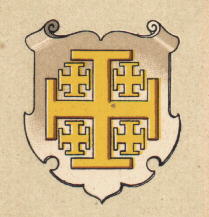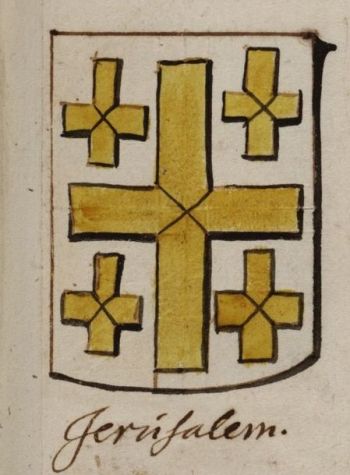Kingdom of Jerusalem: Difference between revisions
Knorrepoes (talk | contribs) m (Text replace - "[[Literature" to "{{media}} [[Literature") |
Knorrepoes (talk | contribs) m (Text replacement - "===Official blazon===↵↵===Origin/meaning===" to "{| class="wikitable" |+Official blazon |- |'''English''' | blazon wanted |} ===Origin/meaning===") Tags: Mobile edit Mobile web edit |
||
| (10 intermediate revisions by the same user not shown) | |||
| Line 1: | Line 1: | ||
{ | {{il}} | ||
| | '''KINGDOM OF JERUSALEM''' | ||
| | |||
[[FIle:jerusale.ahe.jpg|center|Arms (crest) of {{PAGENAME}}]] | |||
{| class="wikitable" | |||
|+Official blazon | |||
|- | |||
|'''English''' | |||
| blazon wanted | |||
|} | |} | ||
===Origin/meaning=== | |||
The Kingdom of Jerusalem is an ancient medieval Kingdom, now in [[Israel]], [[Palestine]] and [[Jordan]]). | |||
The cross for the Kingdom of Jerusalem dates from the 12<sup>th</sup> century and is one of the few exceptions in heraldry where a shield consists only of the two metals, silver and gold. Perhaps it was thought that, by deliberately using, as most worthy for so sacred a purpose, the two precious metals, and thereby contravening the rules which ordinarily govern heraldry, special attention would be drawn to the very distinguished character of the status of Jerusalem as a Holy City. | |||
In 1099 the crusaders entered Jerusalem for the first time and, in the following year, they erected the city together with certain adjacent provinces, into a Christian kingdom. On Christmas Day in that same year, 1100, they crowned their first king, Baldwin, son of Eustace Count of Boulogne. | |||
All the kings of Jerusalem, from the twelfth century onwards, whether they were actual, titular or claimant, are credited with having used the Arms: "argent a cross potent between four plain crosses or," alone, impaled by, or quartered with their own Arms. | |||
The actual meaning of the cross, besides a symbol of Christianity, is not known. Several meanings have been proposed:<br> | |||
- the cross is a combination of an I and an H, placed one upon the other, forming a variation of the " Monogram of Christ" (the initial letters of the name of Jesus in Greek) or perhaps the initial letters of the Latin form of Jerusalem<br> | |||
- the cross represents the hilts and pommels of four swords laid in the form of the cross, combining the Crusades with the Holy City. | |||
The main cross is always a cross potent, but the small crosses are shown either as normal crosses, or as crosses potent. The reasons thereof are not known. | |||
The arms and title were used by the Austrian Emperors, but the area never formed part of the Austrian-Hungarian Empire. The Emperors, however, put a claim on the Kingdom, which existed during the crusades. The claim was based on a long range of successions. The Kingdom was first claimed by the Kings of Antiochia (now in [[Syria]]). In 1277 Maria of Antiochia granted the claim to King Charles II of Sicily from the Anjou dynasty. Through marriage the arms appeared in the arms of the Dukes of [[Lorraine]] in 1420. The Duchy of [[Lorraine]] became a possession of the Habsburg family, later Emperors of Austria-Hungary. | |||
The | |||
The Kings of Aragon and through these the Spanish Kings also claimed the succession from the King of Sicily and used the same cross in their arms. | The Kings of Aragon and through these the Spanish Kings also claimed the succession from the King of Sicily and used the same cross in their arms. | ||
{|align="center" | {|align="center" | ||
|align="center"|[[File:jerusalem.jpg|center|350 px]] <br/>The arms in a glass-stained window in the Broodhuis in Brussels | |align="center"|[[File:{{PAGENAME}}.hes.jpg|350 px|center|Arms of {{PAGENAME}}]]<br/>The arms in the [[Wapen- en Vlaggenboek Hesman|Wapen- en Vlaggenboek]] van Gerrit Hesman (1708) | ||
|align="center"|[[File:jerusalem.jpg|center|350 px|Arms of {{PAGENAME}}]] <br/>The arms in a glass-stained window in the Broodhuis in Brussels | |||
|} | |} | ||
Latest revision as of 14:03, 29 January 2024
| Heraldry of the World |
| Israeli heraldry portal |
|
KINGDOM OF JERUSALEM
| English | blazon wanted |
Origin/meaning
The Kingdom of Jerusalem is an ancient medieval Kingdom, now in Israel, Palestine and Jordan).
The cross for the Kingdom of Jerusalem dates from the 12th century and is one of the few exceptions in heraldry where a shield consists only of the two metals, silver and gold. Perhaps it was thought that, by deliberately using, as most worthy for so sacred a purpose, the two precious metals, and thereby contravening the rules which ordinarily govern heraldry, special attention would be drawn to the very distinguished character of the status of Jerusalem as a Holy City.
In 1099 the crusaders entered Jerusalem for the first time and, in the following year, they erected the city together with certain adjacent provinces, into a Christian kingdom. On Christmas Day in that same year, 1100, they crowned their first king, Baldwin, son of Eustace Count of Boulogne.
All the kings of Jerusalem, from the twelfth century onwards, whether they were actual, titular or claimant, are credited with having used the Arms: "argent a cross potent between four plain crosses or," alone, impaled by, or quartered with their own Arms.
The actual meaning of the cross, besides a symbol of Christianity, is not known. Several meanings have been proposed:
- the cross is a combination of an I and an H, placed one upon the other, forming a variation of the " Monogram of Christ" (the initial letters of the name of Jesus in Greek) or perhaps the initial letters of the Latin form of Jerusalem
- the cross represents the hilts and pommels of four swords laid in the form of the cross, combining the Crusades with the Holy City.
The main cross is always a cross potent, but the small crosses are shown either as normal crosses, or as crosses potent. The reasons thereof are not known.
The arms and title were used by the Austrian Emperors, but the area never formed part of the Austrian-Hungarian Empire. The Emperors, however, put a claim on the Kingdom, which existed during the crusades. The claim was based on a long range of successions. The Kingdom was first claimed by the Kings of Antiochia (now in Syria). In 1277 Maria of Antiochia granted the claim to King Charles II of Sicily from the Anjou dynasty. Through marriage the arms appeared in the arms of the Dukes of Lorraine in 1420. The Duchy of Lorraine became a possession of the Habsburg family, later Emperors of Austria-Hungary.
The Kings of Aragon and through these the Spanish Kings also claimed the succession from the King of Sicily and used the same cross in their arms.
The arms in the Wapen- en Vlaggenboek van Gerrit Hesman (1708) |
The arms in a glass-stained window in the Broodhuis in Brussels |
Contact and Support
Partners:
Your logo here ?
Contact us
© since 1995, Heraldry of the World, Ralf Hartemink 
Index of the site
Literature : Ströhl, 1890















